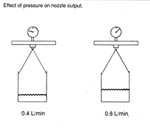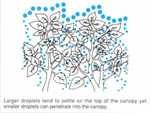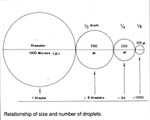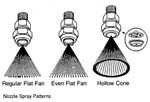The objective of all pesticide applications is to apply the correct rate of the recommended product uniformly to the target without contaminating non-target areas. To achieve this, suitable application equipment must be operated correctly and external environmental factors such as the weather must always be considered.
Calibration
Calibration is a procedure that will assure that the pesticide will be uniformly applied to the target at the correct rate.
A nonuniform application can occur from either a variation in nozzle output across the width of the boom or by localized variations occurring over the treatment area. Most common problems resulting in nonuniformity across the width of the boom are from variations in the nozzle orifice size, pressure or nozzle spacing. Most common problems resulting in localized variations in the treatment area are from variations in the forward speed, operating pressure, or boom movement. To ensure that a uniform application will occur each of the potential variations must be minimized.
Nozzle calibration is a procedure that assesses uniformity by determining the output of each nozzle on the boom. A visual inspection of the nozzle spray pattern should be made to detect nozzle clogging and/or damage. The output of each nozzle is compared to the average value of the set. In addition, the output value is compared to that of a new nozzle to assess the amount of wear. If a nozzle is worn by more than 15 percent it should be replaced. The spray pattern of worn nozzles becomes distorted and will disrupt uniformity. This distortion cannot be detected by a visual inspection.
Application rates can be determined by a mathematical formula. This allows the producer to quickly examine a variety of situations saving valuable field time.
For more information refer to the operator's manual or to Agriculture Canada's publication 1849 entitled Field Sprayers.




